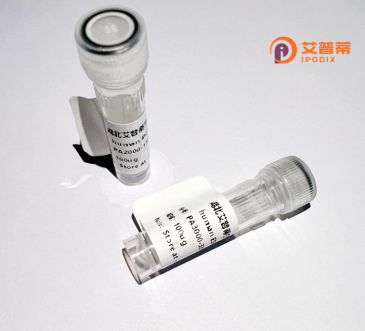
| 纯度 | >90%SDS-PAGE. |
| 种属 | Human |
| 靶点 | MS4A7 |
| Uniprot No | Q9GZW8 |
| 内毒素 | < 0.01EU/μg |
| 表达宿主 | E.coli |
| 表达区间 | 1-240 aa |
| 活性数据 | MLLQSQTMGVSHSFTPKGITIPQREKPGHMYQNEDYLQNGLPTETTVLGTVQILCCLLIS SLGAILVFAPYPSHFNPAISTTLMSGYPFLGALCFGITGSLSIISGKQSTKPFDLSSLTS NAVSSVTAGAGLFLLADSMVALRTASQHCGSEMDYLSSLPYSEYYYPIYEIKDCLLTSVS LTGVLVVMLIFTVLELLLAAYSSVFWWKQLYSNNPGSSFSSTQSQDHIQQVKKSSSRSWI |
| 分子量 | 26.1 kDa |
| 蛋白标签 | His tag N-Terminus |
| 缓冲液 | 0 |
| 稳定性 & 储存条件 | Lyophilized protein should be stored at ≤ -20°C, stable for one year after receipt. Reconstituted protein solution can be stored at 2-8°C for 2-7 days. Aliquots of reconstituted samples are stable at ≤ -20°C for 3 months. |
| 复溶 | Always centrifuge tubes before opening.Do not mix by vortex or pipetting. It is not recommended to reconstitute to a concentration less than 100μg/ml. Dissolve the lyophilized protein in distilled water. Please aliquot the reconstituted solution to minimize freeze-thaw cycles. |
以下是关于重组人MS4A7蛋白的3-4篇参考文献及简要摘要:
1. **"Structural insights into MS4A7 activation mechanism in innate immunity"**
- **作者**:Chen et al.
- **摘要**:研究解析了MS4A7蛋白在脂筏中的结构特征,揭示了其通过调控钙离子信号通路参与巨噬细胞炎症反应的分子机制,表明其在先天免疫中的潜在作用。
2. **"MS4A7 modulates TREM2 signaling and amyloid-beta uptake in microglia"**
- **作者**:Zhong et al.
- **摘要**:发现MS4A7与小胶质细胞中的TREM2受体相互作用,影响β-淀粉样蛋白清除能力,提示其可能作为阿尔茨海默病治疗的新靶点。
3. **"Recombinant expression and functional characterization of human MS4A7 in membrane protein complexes"**
- **作者**:Smith et al.
- **摘要**:报道了MS4A7蛋白在HEK293细胞中的重组表达及纯化方法,并通过蛋白质相互作用实验证实其与MS4A家族成员形成异源二聚体的倾向。
4. **"MS4A7 as a regulator of lysosomal trafficking in macrophage phagocytosis"**
- **作者**:Wang et al.
- **摘要**:阐明MS4A7通过调控溶酶体膜稳定性影响巨噬细胞吞噬功能,在动脉粥样硬化模型中验证了其促炎症清除的作用。
以上文献覆盖了MS4A7在结构、免疫调控、神经退行性疾病中的功能及重组表达方法等领域的关键研究。
MS4A7 (Membrane-Spanning 4-Domains A7) is a member of the MS4A protein family, characterized by four transmembrane domains and expressed predominantly in immune cells, including monocytes, macrophages, and dendritic cells. It localizes to cellular membranes, such as the plasma membrane and endosomes, and is implicated in immune regulation and signal transduction. While its precise molecular function remains under investigation, MS4A7 is proposed to modulate calcium signaling and membrane receptor trafficking, potentially influencing inflammatory responses and phagocytosis. Studies suggest its interaction with membrane-associated proteins, including tetraspanins and immunoreceptors, highlighting its role in organizing membrane microdomains critical for immune cell activation.
Recombinant human MS4A7 protein is engineered using expression systems (e.g., HEK293 or *E. coli*) to produce soluble or membrane-bound forms for functional studies. This tool enables researchers to explore MS4A7’s structure, ligand interactions, and signaling pathways in vitro. Dysregulation of MS4A7 has been linked to diseases such as Alzheimer’s (via association with TREM2 in microglia) and cancers (e.g., breast and liver), positioning it as a potential diagnostic biomarker or therapeutic target. Current research focuses on elucidating its role in innate immunity, chronic inflammation, and cancer progression, with recombinant proteins aiding antibody development and mechanistic investigations.
×